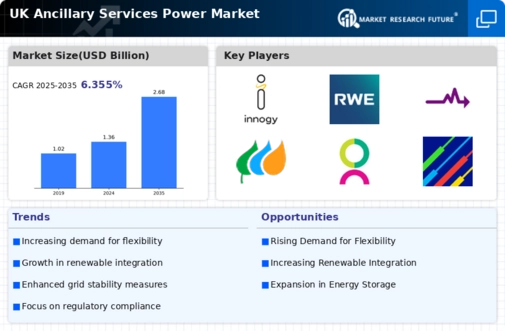Growing Demand for Grid Stability
The increasing integration of renewable energy sources into the energy mix has led to a heightened demand for grid stability within the ancillary services-power market. As the share of intermittent energy sources, such as wind and solar, rises, the need for ancillary services to balance supply and demand becomes critical. In the UK, the National Grid has reported that the contribution of renewables to the energy mix reached approximately 48% in 2025. This shift necessitates robust ancillary services to ensure reliability and prevent outages, thereby driving investment in this sector. The ancillary services-power market is thus positioned to expand as utilities and grid operators seek solutions to maintain grid integrity amidst fluctuating energy generation.
Regulatory Support for Ancillary Services
Regulatory frameworks play a crucial role in shaping the ancillary services-power market. The UK government has introduced various policies aimed at promoting the reliability and efficiency of the energy system. For instance, the Capacity Market mechanism incentivizes the provision of ancillary services by ensuring that providers are compensated for their contributions to grid stability. This regulatory support is essential for attracting investment and encouraging participation from a diverse range of service providers. As the regulatory landscape continues to evolve, it is anticipated that the ancillary services-power market will experience growth, driven by the need for compliance and the pursuit of operational excellence.
Increased Investment in Energy Infrastructure
Investment in energy infrastructure is a pivotal driver for the ancillary services-power market. The UK government has committed to substantial funding for upgrading and modernizing the energy grid, with an estimated £40 billion allocated for infrastructure improvements by 2030. This investment aims to enhance the capacity and resilience of the grid, facilitating the integration of diverse energy sources. As infrastructure evolves, the demand for ancillary services, such as frequency response and voltage control, is likely to increase. Consequently, the ancillary services-power market is expected to benefit from this influx of capital, fostering innovation and the development of new service offerings to meet the changing needs of the energy landscape.
Technological Innovations in Energy Management
Technological advancements in energy management systems are transforming the ancillary services-power market. Innovations such as smart grid technologies and advanced analytics enable more efficient monitoring and control of energy resources. These technologies facilitate real-time data analysis, allowing for improved decision-making regarding the provision of ancillary services. In the UK, the adoption of such technologies is expected to enhance the responsiveness of the grid, thereby increasing the overall efficiency of energy distribution. As these innovations proliferate, they are likely to create new opportunities within the ancillary services-power market, fostering a more dynamic and responsive energy ecosystem.
Rising Consumer Participation in Energy Markets
The growing trend of consumer participation in energy markets is influencing the ancillary services-power market. With the advent of smart meters and demand response programs, consumers are increasingly able to engage in energy management. This shift allows consumers to contribute to grid stability by adjusting their energy usage in response to market signals. In the UK, it is estimated that consumer participation could account for up to 20% of ancillary service provision by 2030. This active involvement not only empowers consumers but also enhances the overall resilience of the energy system, thereby driving growth in the ancillary services-power market.





















Leave a Comment